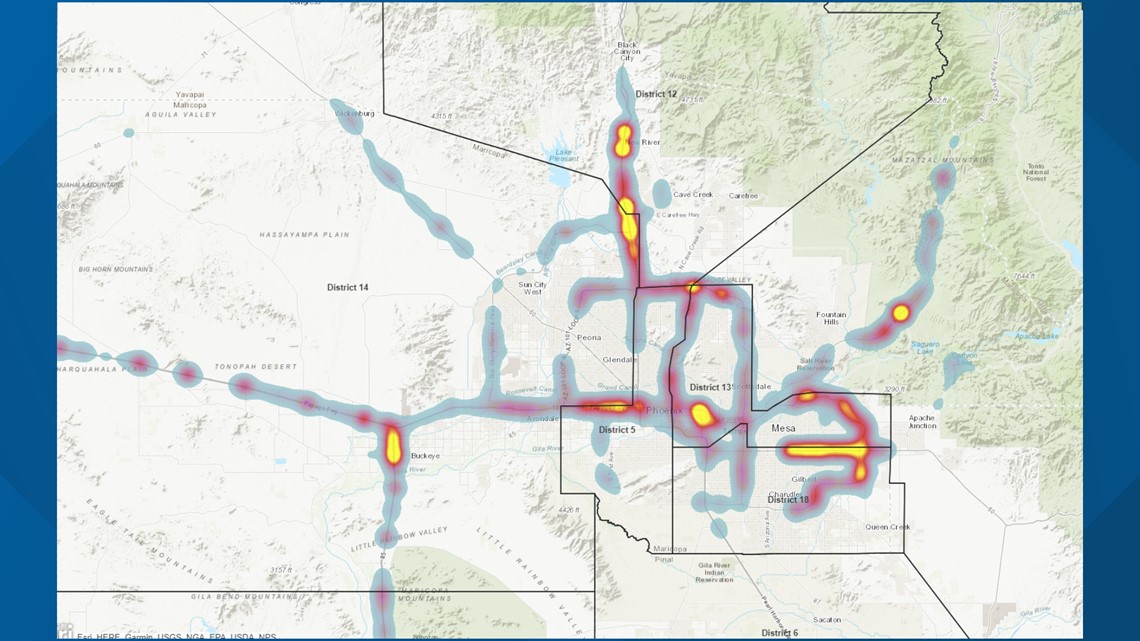MARICOPA COUNTY, Ariz. — Whenever he was on the 101 or the 202, Tempe resident David Pearson never felt like he was going fast enough for the other drivers.
"No matter how fast I went, there were always people who would pull up right behind me and honk their horn," Pearson said. "It started during COVID, I noticed fewer and fewer cars but the ones that were there were going faster and faster and faster."
But what Pearson didn’t see were those same drivers getting pulled over. Between speeding travelers and a perceived lack of traffic stops, Valley highways can feel unsafe. But while the Arizona Department of Public Safety admits they’re short in the Highway Patrol Division by almost 200 troopers, the optics don’t reflect the data. In fact, the number of Valley drivers getting speeding tickets is on the rise.
So why do the highways still feel like racetracks?
12News obtained data from the Maricopa County Justice Courts showed the thousands of speeding cases the court has processed each year since 2014.
The numbers are only growing
DPS Sgt. Eric Andrews has an inside view of the data. He’s been with the department since 2014 and previously helped to manage the Highway Patrol Division’s fleet of troopers.
What the data showed was that the highest number of speeding tickets were written in the Valley in 2016, then a low in 2020, and a rise of tickets written since then.
DPS heat maps show where they've caught drivers speeding the most since 2016.
Consistent hotspots over the years include places like I-17 north of the 101, the 60 east in Mesa and the 101 at milepost 11 - right about Grand Avenue.
"Those heat maps specifically are showing when we're catching people," Andrews said. "I think they're speeding all over the place and like I said, the congestion and the traffic plays into it."


"In 2020, it plummeted because we did not have traffic on the road, especially for several of those months, nobody was on the road. Since then, it has been growing steadily," Andrews said.


With fewer people traveling between cities for work during the pandemic, those roadways saw little use.
The hotspots on the map were glowing brighter than ever by 2023 and new ones cropped up across the Valley.


The Arizona Department of Public Safety writes all of its tickets through justice courts. Other local police departments also write tickets through the justice courts, but more often they file tickets through city courts, impacting some of the data. Different recording methods mean that it’s difficult to give an exact count of the roughly 30,000 - 40,000 of citations in the Valley each year, but the trends are still observable.
It’s not just that there are more speeders, there are more people in general. The Valley’s population has grown by more than half a million from 2016 to 2023, according to data from the Maricopa Association of Governments.
"When it's rush hour in the morning or in the evening, troopers are going from call to call to call," Andrews said. "We are purely reactive, we cannot be proactive because we have so many calls, so few troopers, so many people on the road."
DPS is stretched thin, and stopping speeding drivers is a constant effort.
>> Download the 12News app for the latest local breaking news straight to your phone.
Staffing challenges slow enforcement
Andrews looked back at the data that the department keeps, noting that while speeding enforcement is a priority for DPS, there have been challenges. The Highway Patrol Division of DPS alone is short 183 troopers statewide, Andrews said.
"That's a lot of people that we're short, just like every other agency is short right now," Andrews said. "We're doing everything we can to do recruiting."
The problem isn’t unique to Arizona. Chuck Farmer with the Insurance Institute for Highway Safety (IIHS) says it's happening across the country.
"When I speak to police officers, they tell me it's two things: One is budgeting and another big one is just recruitment," Farmer said. "They can't recruit enough officers to get them out there to patrol for these dangerous drivers."
But Farmer said IIHS studies have shown that speeding enforcement stops behavior, but only while it's being enforced.
"We measured speeds before, during and after the enforcement campaign and saw like an 80% decrease in speeders," Farmer said. "The thing is once you stop the enforcement that comes right back up."
Despite the staffing challenge, troopers are still ticketing on Valley freeways.
"Our main concept and point of pulling somebody over is not to give them a ticket, it's to change their driving behavior," Andrews said.
Still, speed is dangerous on the road.
"In the long run, is that really worth you risking your life, risking the lives of the kids that may be in your car, of the motoring public around you? Is that really worth one to two minutes? Absolutely not," Andrews said.
Up to Speed
Catch up on the latest news and stories on the 12News YouTube channel. Subscribe today.

